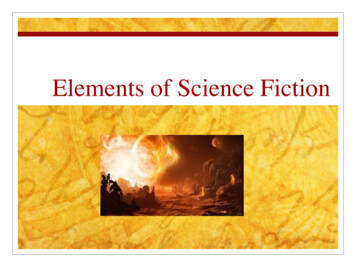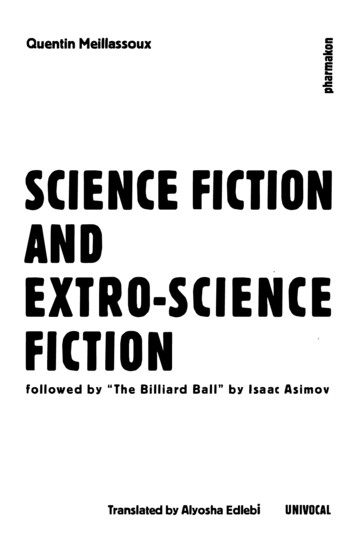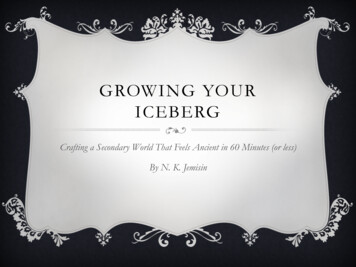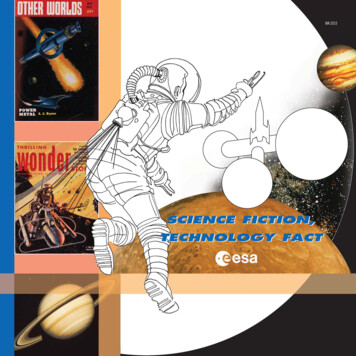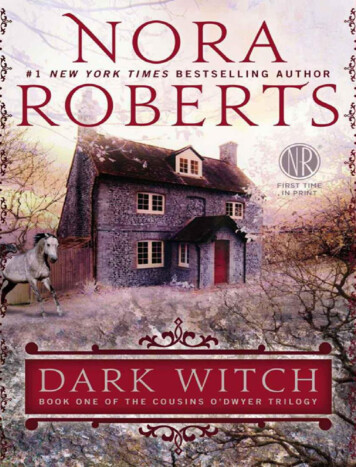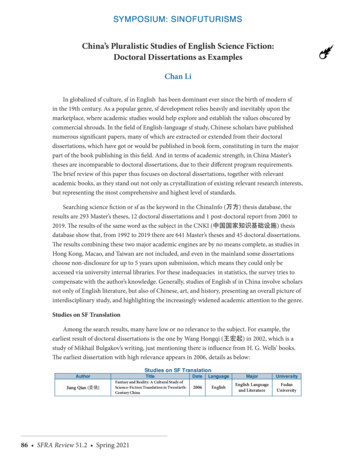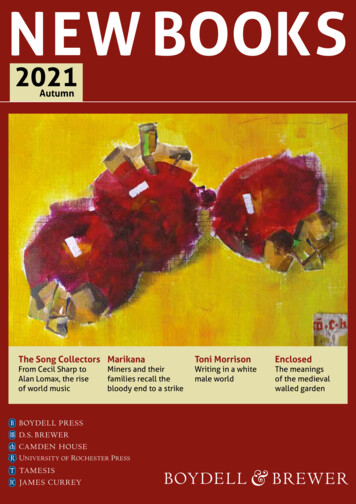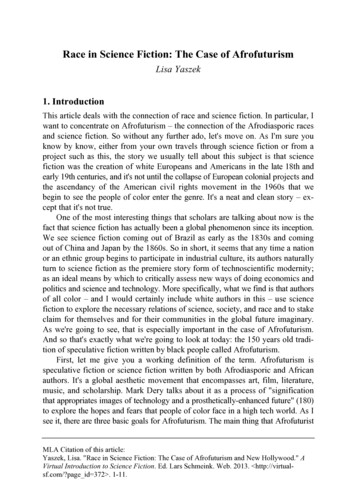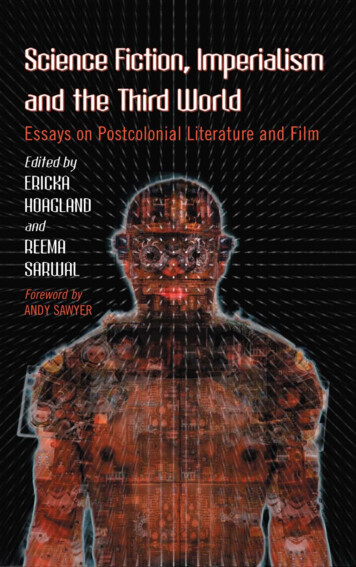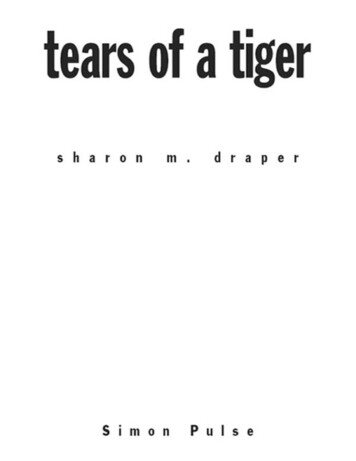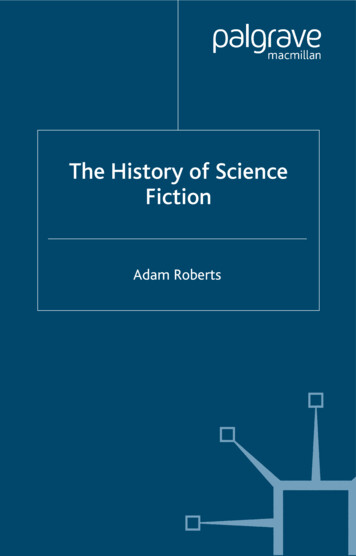
Transcription
The History of ScienceFictionAdam Roberts
The History of Science Fiction
Palgrave Histories of LiteratureTitles include:Adam RobertsTHE HISTORY OF SCIENCE FICTIONForthcoming titles in the series:Andrew PepperTHE HISTORY OF CRIME WRITINGAdeline Johns-PutraTHE HISTORY OF THE EPICPalgrave Histories of LiteratureSeries Standing Order ISBN 1–4039–1196–7 (hardback) 1–4039–1197–5 (paperback)(outside North America only)You can receive future titles in this series as they are published by placing a standing order.Please contact your bookseller or, in case of difficulty, write to us at the address below withyour name and address, the title of the series and the ISBN quoted above.Customer Services Department, Macmillan Distribution Ltd, Houndmills, Basingstoke,Hampshire RG21 6XS, England
The History of ScienceFictionAdam Roberts
Adam Roberts 2006All rights reserved. No reproduction, copy or transmission of thispublication may be made without written permission.No paragraph of this publication may be reproduced, copied or transmittedsave with written permission or in accordance with the provisions of theCopyright, Designs and Patents Act 1988, or under the terms of any licencepermitting limited copying issued by the Copyright Licensing Agency, 90Tottenham Court Road, London W1T 4LP.Any person who does any unauthorised act in relation to this publicationmay be liable to criminal prosecution and civil claims for damages.The author has asserted his right to be identifiedas the author of this work in accordance with the Copyright,Designs and Patents Act 1988.First published 2006 byPALGRAVE MACMILLANHoundmills, Basingstoke, Hampshire RG21 6XS and175 Fifth Avenue, New York, N.Y. 10010Companies and representatives throughout the world.PALGRAVE MACMILLAN is the global academic imprint of the PalgraveMacmillan division of St. Martin’s Press, LLC and of Palgrave Macmillan Ltd.Macmillan is a registered trademark in the United States, United Kingdomand other countries. Palgrave is a registered trademark in the EuropeanUnion and other countries.ISBN-13: 978–0–333–97022–5 hardbackISBN-10: 0–333–97022–5 hardbackThis book is printed on paper suitable for recycling and made from fullymanaged and sustained forest sources.A catalogue record for this book is available from the British Library.A catalog record for this book is available from the Library of Congress.10 9 8 7 6 5 4 3 2 115 14 13 12 11 10 09 08 07 06Printed and bound in Great Britain byAntony Rowe Ltd, Chippenham and Eastbourne
ContentsPrefacevii1. Definitions12. Science Fiction and the Ancient NovelInterlude: AD 400–160021323. Seventeenth-Century Science Fiction364. Eighteenth-Century Science Fiction645. Early Nineteenth-Century Science Fiction886. Science Fiction 1850–19001067. Jules Verne and H. G. Wells1298. The Early Twentieth Century: High Modernist Science Fiction1569. Early Twentieth-Century Science Fiction: The Pulps17310. Golden Age Science Fiction 1940–196019511. The Impact of New Wave Science Fiction 1960s–1970s23012. Science Fiction Screen Media 1960–2000: Hollywood Cinemaand Television26413. Prose Science Fiction 1970s–1990s29514. Late Twentieth-Century Science Fiction: Multimedia, VisualScience Fiction and Others326Postscript: Twenty-First-Century Science Fiction341Chronology of Key Titles in Science Fiction and Developmentsin Science346Notes351Further Reading359Index360v
This page intentionally left blank
PrefaceScience fiction is too large a subject to be represented exhaustively in a CriticalHistory, even in one such as this, which has been allowed fairly ample dimensions.The reader seeking greater comprehensiveness is advised to consult John Clute andPeter Nicholls’ astonishingly full Encyclopedia of Science Fiction. The present studyis not a complete account of the genre, but rather an attempt to trace a line thatconnects one specific mode of ‘fantastic’ literature, which we now call sciencefiction, from earliest times through to the present day. The majority of texts examined are novels, short or long, and these remain the dominant form of SF,although the ‘short story’ (a slightly different thing from ‘short novels’), cinema,television, comic books and other forms of cultural production play an increasingly large part in the later stages. As a Critical History, this work also has a certaincase to make. I hope to avoid tendentiousness, but my argument is not neutral –even if such a thing as a purely neutral critical argument could exist – and I sketchit out here so that readers can be forewarned and prepare themselves to read whatfollows in a sympathetic or hostile frame of mind, whichever suits them better.I argue that the roots of what we now call science fiction are found in thefantastic voyages of the Ancient Greek novel; and I use the Vernean phrase voyagesextraordinaires, which I find to be the most supple and useful descriptor for thesesorts of texts. Narratives of travel and adventure, often with fantastic (which is tosay, impossible or fantastical) interludes, were among the most popular modes ofancient culture: the epic provides many examples, such as Odysseus’ encounterwith the Cyclops or with the sorceress Circe, who turned his men into pigs. Nor isthis a surprising cultural development, given that the Greeks had a culture inwhich actual travel and exploration played major roles. I argue that among thesemany accounts of lengthy and entertaining sea voyages, or treks by land, is a category of voyages extraordinaires of a different sort: voyages into the sky, and especially voyages to other planets. It was possible for a Greek, in theory, to charter aship and travel to the Gates of Herakles, or to India, or even (we can hypothesise,although there is no evidence that such voyages took place) beyond the settingsun to the Fortunate Islands, to America or the Arctic wastes. This is merely to saythat the technologies of travel available to the Greeks enabled such voyages. But itwas of course not possible for these people to travel to the Moon, as AntoniusDiogenes’ protagonists do. Moving the journey upwards represents a radical departure in the mode of traveller’s tales.In other words, I am arguing that the ur-form of the SF text is ‘a story aboutinterplanetary travel’. It still seems to me that stories of journeying through spaceform the core of the genre, although many critics would disagree. Travels ‘upwards’through space, or sometimes ‘downwards’ into hollow-earth marvels (distinguishedfrom more conventional ‘ordinary’ travels over the surface of the globe), are thetrunk, as it were, from which the various other modes of SF branch off. Speakingvii
viii The History of Science Fictionbroadly, these other branches are twofold. First, there are ‘travels through time’ asa corollary of ‘travels through space’. It is not, I think, coincidental that thissub-genre comes into being and rapidly becomes vigorous in the late nineteenthcentury and throughout the twentieth – which is to say, at the time that ‘science’was establishing the intimate interrelations between these quantities of ‘time’ and‘space’. A second branch, a major bough in fact (to continue the metaphor), is‘stories about technology’. Because long-distance travel already involves a range ofcomplex technologies – as (for example) sail ships, technologies of long-term lifesupport away from land, navigation, military ordnance and various others – it isagain not surprising that ‘tales of technology’ begin as embedded elements inextraordinary voyages. The android woman, fluent in all the world’s languages,encountered in Charles Sorel’s Gazettes et nouvelles ordinaires de divers pays lointains(‘Gazettes and News from Various Faraway Countries’, 1632) represents, perhaps,the first instance of this sort of SF; although through the nineteenth century thismode can be seen separating itself off from the voyage to become a much moredistinct sub-genre. Jules Verne is the first genius of ‘technology fiction’, and by thetwentieth century techno-fiction had arguably become the dominant form of SF.In my first chapter I discuss ‘science fiction’ and ‘technology fiction’ as deservingequivalent theoretical attention.These three forms, broadly conceived, delineate my rough sense of what SF ‘is’:stories of travel through space (to other worlds, planets, stars), stories of travelthrough time (into the past or into the future) and stories of imaginary technologies (machinery, robots, computers, cyborgs and cyber-culture). There is a fourthform, utopian fiction, which is often discussed by critics of science fiction asbelonging to any reasonable definition of the form. My assumption in this studyis that utopian fiction is indeed science fiction, although it takes as its startingpoint philosophy and social theory. We might say that the ‘novum’ (or newthing), the nub of Darko Suvin’s definition of SF, in Utopia is ‘a new social organisation’, and for many critics this is enough to make the book science-fictional.I argue in this study that utopian fiction must be discussed as a parallel development to SF, including as it often does voyages to distant lands or into differenttimes, and facilitated with different technologies. But it is easy to see why somecritics wish to exclude utopias from a discussion of SF: because utopian writing isfundamentally a satiric mode of literature; that takes its force from the impliedcontrast between the ‘ideal’ society being described and the imperfect world inwhich the author and his/her readers actually live.When it comes to SF I cling, perhaps naively, to the belief that the worldsencountered in the genre’s best texts are more than simply modified forms of thisworld – which is to say that SF embodies a genuine and radical Will to Otherness,a fascination with the outer reaches of imaginative possibility. Not all utopias partake of this alterity, but utopias must be discussed nevertheless. For one thing,many practitioners of SF have regarded utopian fiction as part of their practice andhave themselves written utopias. For another, as SF developed it became more andmore concerned with the intricacies of ‘world-building’, in which writers construealternative but self-consistent societies. World-building has now become one of
Preface ixthe most prized things that SF provides its readers, and much of the grammar ofsuch constructions derives from utopian fiction. So, although developing independently of the genre, utopian writing becomes a sort of para-SF, entwining itselfround the genre in the nineteenth and twentieth centuries.1This thumbnail sketch already implies one of the major questions that must beaddressed by any historian of science fiction. We may take the form as commencing with the interplanetary voyages extraordinaires of the Ancient Greek novel; wemay then trace the development of these ideas through seventeenth-century workssuch as Kepler’s Somnium (1634), Godwin’s The Man in the Moone, or a Discourse of aVoyage Thither by Domingo Gonsales, the Speedy Messenger (1638) and Cyrano deBergerac’s Voyage à la lune (1655). From this period it is possible to identify an effectively unbroken line of continual textual production in the science-fictional mode.The question, then, is: Why is there so pronounced and so lengthy a gap in therecord between the Greeks and the Renaissance? Over a thousand years passesbetween these two periods in which science fiction is not written. Why?While no answer to this question could be definitive, several possibilities suggestthemselves. In the present work I argue a particular line, and it happens to haveimportant consequences for my definition of science fiction. Accordingly, it isworth rehearsing here. Stating the case briefly, I argue that the re-emergence ofscience fiction is correlative to the Protestant Reformation. During the latesixteenth and early seventeenth centuries the balance of scientific enquiry shiftedto Protestant countries, where the sort of speculation that could be perceived ascontrary to biblical revelation could be undertaken with more (although not total)freedom. René Descartes, for instance, settled in Holland in 1629, in part becausehis native French Catholic culture was proving to be hostile to his scientificenquiries. In Descartes’ mind was the recent condemnation of Galileo’s astronomical work by the Catholic Church, a shocking development for many scientificthinkers at that time. Indeed, there were more troubling developments than this,especially for the more imaginatively minded (which is to say, science-fictional)thinkers.A little-known but none the less key development in the history of the genre,I would argue, occurred in 1600 when Giordano Bruno the Nolan was burned atthe stake by the Catholic Inquisition in Rome. Bruno’s crime had been to arguethat the universe was infinite and contained innumerable worlds – an example ofspeculative rather than empirical science, and accordingly science-fictional. Brunowas condemned to death for contradicting the teaching of the Catholic Church,but it takes a moment’s consideration to realise why the idea of innumerableinhabited worlds was deemed so shocking. Dante, for instance, postulated inhabitants on the various worlds of his cosmos (although, of course, his poem is situatedin a Ptolemaic rather than a Copernican solar system), and his writing wasconsidered to be pious rather than otherwise.The problem, identified and discussed brilliantly (though eccentrically) byWilliam Empson in his posthumously published Essays on Renaissance Literature(1993), can be put in these terms: if there are many worlds, with many populationsof beings living on them, then this tends to deny the uniqueness of the crucifixion
xThe History of Science Fictionand so devalue Christianity itself, perhaps terminally. The Church teaches thatGod sent Christ to Earth to save humanity, a race created in His image. This was asingular, miraculous event, a sacrament that connects humanity to God, or at leastprovides humanity with the possibility of that connection. But if humanity is butone among many populations of beings in the cosmos, what of the others? Havethey too been redeemed by their own Christs (a possibility that would fatallydegrade the uniqueness of Christ’s sacrifice in this world) or has God simply omitted to provide them with salvation (which paints God in a very cruel light)? Underthe logic of the Ptolemaic system the solar system is a sort of extension of theEarth, inhabited by human souls or angels created directly by God, and the starsare a fixed sphere, making an immense, decorative backdrop. In this cosmos asingle Christ can redeem everything. But if the cosmos is infinite, this beliefbecomes difficult to sustain.The revolutionary point of the Copernican cosmos is wholly to reconfigure thefocus away from Earth and mankind. Either Christ died only once and God hasignored the rest of this vast creation, or he died in every possible world. As Empsonputs it, ‘either the Father had been totally unjust to the Martians, or Christ wascrucified on Mars too; indeed, on all inhabited planets, so that his identity in anyone appearance became precarious’ (Empson, 1: 130). Half a century later this ideawas still so shocking and destabilising to Catholic orthodoxy that Bruno wasburned to death even for implying it.2This may seem like an obscure point of theological quibbling, but I suggest thatit marks a crucial point of cleavage in the development (or redevelopment) ofwestern science fiction. To an orthodox Catholic imagination a plurality of inhabited worlds becomes an intolerable supposition; other stars and planets become atheological rather than a material reality, as they were for Dante – a sort of spiritualwindow-dressing to God’s essentially human-sized creation. But to a Protestantimagination (or to a sceptical humanist Catholic imagination, such as Descartes’or Voltaire’s) the cosmos expands before the probing inquiries of empirical sciencethrough the seventeenth and eighteenth centuries, and the imaginative-speculativeexploration of that universe expands with it. This is the science fiction imagination, and it becomes increasingly a function of western Protestant culture. Fromthis SF develops as an imaginatively expansive and (crucially) materialist mode ofliterature, as opposed to the magical-fantastic, fundamentally religious mode thatcomes to be known as Fantasy.This, in turn, connects with another form of definition often applied to themode: science fiction, in contemporary publishing and bookselling practice, is distinguished from ‘Fantasy’, the latter involving tales of fantastic or non-realist formin which the mechanism for the fantasy is magic rather than technology. The keytext in the development of twentieth-century Fantasy (a genre of astonishing andcontinuing fertility) is J. R. R. Tolkien’s Lord of the Rings (1952–53); elves, men anddwarves, aided by a wizard, battle malign orcs and monsters as part of a cosmic warbetween the forces of ‘good’ and ‘evil’, the latter epitomised by Sauron, an evil, yetgod-like being. There are very few machines in Lord of the Rings, and most of thosethat do appear are aligned with the forces of evil. Instead, it is magic that operates
Preface xiin the world to good or ill effect. The action revolves around a golden ring imbuedwith magical powers, a device that renders the wearer invisible but also grants thering-bearer enormous power-to-command.The Lord of the Rings is a profoundly Catholic work, not so much in terms ofconscious allegory (Tolkien always expressed ‘cordial dislike’ for allegory) as in itsdetailed working-out; a drama of fall and redemption, in which a saviour returnsto overthrow evil. The use of a sacramental symbol – the gold band symbolisingmarriage in Christian service – as the core element of the fantasy is also significant.From a Catholic perspective something magical is involved in marriage, ‘magical’in the forceful sense that Jesus’ miracles can also be described as ‘magical’. To aCatholic the communion wafer actually becomes the body of Christ during themass – transubstantiation is a literal process, another magical sacrament. To aProtestant worshipper it is symbolic of Christ, but is otherwise wholly material andbread.This is to revisit the very rationale of the Protestant Reformation itself. NormanDavies, for instance, summarises the movement in the following terms:The Protestant movement contained a very strong impulse to ‘take the magicout of religion’ none the less, in the fifteenth, sixteenth and seventeenthcenturies Europe continued to be devoted to every form of magical belief. Thelandscape was filled with alchemists, astrologers, diviners, conjurers, healersand witches Magic held its own through the Reformation period. In thisrespect, therefore, the Protestant onslaught on magic enjoyed only partial success, even in the countries where Protestantism was to be nominally triumphant. But the intentions of the radicals were unmistakable. After Wycliffecame Luther’s attack on the indulgences (1517) and Calvin’s dismissal of transubstantiation as ‘conjury’ (1536) Protestant Christianity was supposedlymagic-free. (Davies, p. 405)Davies goes on to point out that magic remained, stubbornly, even in this supposedly ‘purged’ religion of rational and conscious belief (‘it proved virtually impossible to abandon the consecration of church buildings, of battle standards, of food,of ships, and of burial grounds’). But a separation begins here in the broad streamof ‘fantastic’ or ‘non-realist’ fiction. ‘Catholic’ imaginations countenance magicand produce traditional romance, magical-Gothic, horror, Tolkienian fantasy andMarquezian magic realism. Protestant imaginations increasingly replace theinstrumental function of magic with technological devices, and produce sciencefiction. This present history depends, then, on a historicised definition of SF asthat form of fantastic romance in which magic has been replaced by the materialist discourses of science.To say this is not to deny a distinctive Catholic strand in science fiction; on thecontrary, I argue that this strand is present in the vast majority of good SF, whetherwritten by Catholic authors or not. If I am asked to condense it into a single sentence, my thesis is that science fiction is determined precisely by the dialecticbetween ‘Protestant’ and ‘Catholic’ (or, if one prefers less sectarian terms, between
xii The History of Science Fiction‘deism’ and ‘magical pantheism’) that emerges out of the seventeenth century. SFtexts mediate these cultural determinants with different emphases, some morestrictly materialist, some more mystical or magical. Many of the most celebratedworks of what is sometimes called ‘Catholic’ SF are deeply embedded in this sacramental, ‘magical’ vision – it is this, I would argue, rather than a fascination withtheological questions as such, that distinguishes ‘Catholic’ SF. So, for instance,Walter M. Miller’s A Canticle for Leibowitz (1959) spreads its narrative over manycenturies, from the aftermath of a nuclear war in which society is reduced to primitivism, to the gradual rebirth of civilisation and the growth of technology again,to the point where mankind again plans rocket trips to the stars, and once morethreatens to destroy itself with nuclear weapons. The coherence of this long narrative is provided by its focus on a group of monks living in the American desert,and in large part Miller provides a detailed, realist-manner description of theirquotidian life. But the novel also depends on several magical turns of events; oneis the character of Leibowitz himself, a hermit in the post-nuclear desert whoseems immortal (the same character appears in each chapter, although they areseparated by centuries), and is indeed specifically identified with the WanderingJew. As the bombs fall for a second time, a mutant, head-like growth on the shoulder of a woman apparently comes to life. The magical element is not merelydropped into the novel for bizarreness’ sake; rather it functions as an endorsementof the supernatural, the presence of God, in a world that had been atom bombruined by societies too purely secular and rational.Gene Wolfe’s Long Sun tetralogy (1993–96) features as its hero a humble priestwith many Graham Greene-like Catholic trappings, although the religion heserves is not Catholicism: the novels take place on a gigantic spaceship, tubeshaped and revolving to provide gravity to those living within it. This ship is on agenerations-long journey to a new world – indeed, the journey has been solengthy that the passengers have forgotten that they inhabit a spaceship at all. Thereligion which Silk, Wolfe’s priest-hero, follows is one in which ‘windows’(advanced TV screens) display the personages of the gods themselves; but over thecourse of the novels these supposed gods are revealed to be nothing but the downloaded personalities of ancient individuals, several of whom have gone mad intheir electronic environment. The overall trajectory of this series presents theunmasking of features of the world that had been taken to be natural and supernatural, revealing them to be nothing but technological – a plotline we mightterm, utilising this crude binary, ‘Protestant’. Yet Catholic Wolfe cannot abandonmagic; a mysterious and non-technological numinous being, ‘the Outsider’, lurksbehind Silk’s actions throughout the book, and the first novel opens with a revelation experienced by Silk in which – magically – the Outsider reaches throughinto the world of the long sun and provides insight. Wolfe’s most famous tetralogy, The Book of the New Sun (1980–87), is also science fiction figured as Fantasy.Severian advances from apprentice Torturer, to Torturer proper, and eventually toworld-emperor, travelling through a world so far into the future that its bizarrerituals and paraphernalia seem utterly magical. The fantastic-magical elementspredominate, and the far-future technological features can never quite be reduced
Preface xiiito materialist explanation: appropriately so because in a manner of speaking theprotagonist, Severian the Torturer, is Christ.The narrative of this Critical History, in other words, sees a nascent form of SF inAncient Greece that disappears, or becomes suppressed, with the rise to culturaldominance of the Catholic Church; and which re-emerges when the new cosmology of the sixteenth century inflects the theology of Protestant thinkers in theseventeenth. The death of Bruno in 1600 is a short-hand for this crux; and the doctrine of the plurality of worlds that engages seventeenth-century thinkers informsalmost all the newer interplanetary texts that SF from this period involves.I discuss the implications of this in greater detail in chapter 4, but in brief thismeans that when interplanetary travel romances return to western culture in theseventeenth and eighteenth centuries, they are all vitally concerned with the theological implications of the aliens they describe. Where a modern-day astronautmight greet extraterrestrials with some benign liberal platitude (‘We come inpeace’), star-travellers in stories from this period are all keen to hear the answer toone crucial question: ‘Do you believe in Jesus Christ?’ When Francis Godwin’shero travels to the Moon and meets aliens there, his first words are ‘Jesus Maria’:No sooner was the word Jesus out of my mouth but young and old fell all downupon their knees, at which I not a little rejoiced, holding up both their handson high, and repeating certain words which I understood not. (Godwin, Man inthe Moone, p. 96)This is important because, for Godwin and his readers, space-aliens are not esotericcuriosities, but crucial proof or disproof of divine truth. In Godwin’s work, hisLunites are closely enough associated with the Earth to be able to share in theearthly Christ’s redemptive power; but all of the space fantasies of this period inwhich aliens are encountered worry away at the question of the plurality of worldsand what this means for Christian revelation. Wilkins’ Discovery of a World in theMoone (1638), for instance, postulates lunar inhabitants, but goes on to questionwhether such beings ‘are the seed of Adam, whether they are in a blessed estate, orelse what means there may be for their salvation’. Wilkins quotes ThomasCampanella to the effect that Lunarians must be ‘liable to the same misery [of original sin] with us, out of which, perhaps, they were delivered by the same means aswe, the death of Christ’ (Wilkins, pp. 186–92). The topic re-emerges regularly in SFthroughout the nineteenth and twentieth centuries. C. S. Lewis, for instance,sends his space-travellers to an inhabited Mars in Out of the Silent Planet (1938);Lewis’s trilogy of science fiction novels are all concerned with such theologicalissues, and his solution to the problem is to argue that Christ is unique to Earthbecause only Earth has fallen into the clutches of the Devil.James Blish’s A Case of Conscience (1958) sees a priest exorcising an entire planet(Lithia) literally out of existence, as a devilish imposture to beguile the faithfulwith the corrosive conceptual possibilities of a Brunoesque multiplicity of inhabited worlds. Blish’s Hugo Award-winning novel is a brilliantly intelligent piece offiction; but reading it from a Catholic perspective is a different experience from
xiv The History of Science Fictionreading it from a non-Catholic one. Under the logic of the former, the novel is aninteresting exploration of a theological conundrum; under the logic of the latter,a heartbreaking story of human arrogance and short-sightedness, with the blameless Lithians terrible victims.More recently, Dan Simmons’ highly regarded Hyperion (1989) opens with astory about a priest haunted by precisely this question: whether Christ is a universalsaviour or merely a parochial, earthbound figure. He travels to a distant corner ofthe galaxy and finds there a race of apparently idiot aliens who all bear a glowingcross on their torsos. The priest, ecstatic, decides that this is proof of the universality of Christ. In the event, the cross shape turns out to be an especially pernicious parasitic form of alien life, which is only coincidentally cruciform, and thepriest is disillusioned. But this theological opening to the Hyperion sequence ofnovels is appropriate. Hyperion establishes that a sadistic creature called the shrikeis kidnapping and inflicting terrible pain on various inhabitants of the planetHyperion; in the novel’s sequel, The Fall of Hyperion, it becomes apparent thatmalign machine intelligences are using the shrike to summon a numinous spirit ofcompassion from its hiding place (the bait being a larger and larger quantity of suffering human beings) so that they can destroy it. That there is a mystical principleof compassion behind the events of the cosmos, in conflict with a ruthless opposite principle, casts a pseudo-Christian battle between Christ and Satan onto agalactic stage.By asserting that this opposition of ‘Protestant/humanist’ technology and‘Catholic’ magic is radically constitutive of science fiction (and necessarily, therefore, by contradistinguishing SF from Fantasy) I may be reminding readers ofArthur C. Clarke’s famous dictum: ‘Any sufficiently advanced technology is indistinguishable from magic’ (Clarke, Profiles of the Future, 1969). But it hardly needspointing out that far from co-opting magic into SF, Clarke’s statement reduces all‘magic’ to technological reality; what seems at first glance to be miraculousbecomes, when properly analysed, only technological, albeit technology of a wonderfully advanced sort. In other words, Clarke in effect denies ‘Catholic’ SF altogether; for him ‘Catholic’ SF is always and inevitably ‘Protestant-humanist’ SF indisguise; something entirely appropriate to Clarke’s own SF corpus, where theapparently ‘transcendent’ (for inst
9.Early Twentieth-Century Science Fiction: The Pulps 173 10.Golden Age Science Fiction 1940–1960 195 11. The Impact of New Wave Science Fiction 1960s–1970s 230 12.Science Fiction Screen Media 1960–2000: Hollywood Cinema and Television 264 13.Prose Science Fiction 1970s–1990s 295 14.Late Twentieth-Cen
